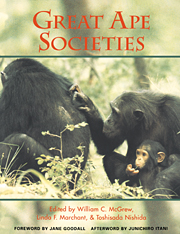Book contents
Afterword: a new milestone in great ape research
Published online by Cambridge University Press: 04 August 2010
Summary
Each manuscript in this volume brings back to me the memory of a scene I witnessed with A. Suzuki in 1965. We were in western Tanzania, 50 km east of the escarpment in no man's land, when we came across an orderly procession of 43 chimpanzees, marching across the Miombo woodland with scarcely a leaf left on the boughs in the dry season (Itani & Suzuki, 1967).
It seems now that everything we must know about chimpanzees was condensed and suggested in the procession we witnessed, but we were unable to decipher the mystery at that moment. The manuscripts in this volume may present the possible answers for those who read this book; and this must have been the reason the manuscripts made me hark back to the scene of 30 years ago.
It was Thomas Huxley (1863), who first articulated the prologue to a plausible scenario recognizing the significance of great apes, especially the importance of inquiring into their relation to the human species, in the first chapter of Evidence as to Man's Place in Nature.
Later, well into the twentieth century, the first milestone was laid along the path towards the composition of a comprehensive scenario on the relationship between humanity and the apes. The milestone was The Great Apes by Robert & Ada Yerkes (1929).
- Type
- Chapter
- Information
- Great Ape Societies , pp. 305 - 308Publisher: Cambridge University PressPrint publication year: 1996
- 1
- Cited by



